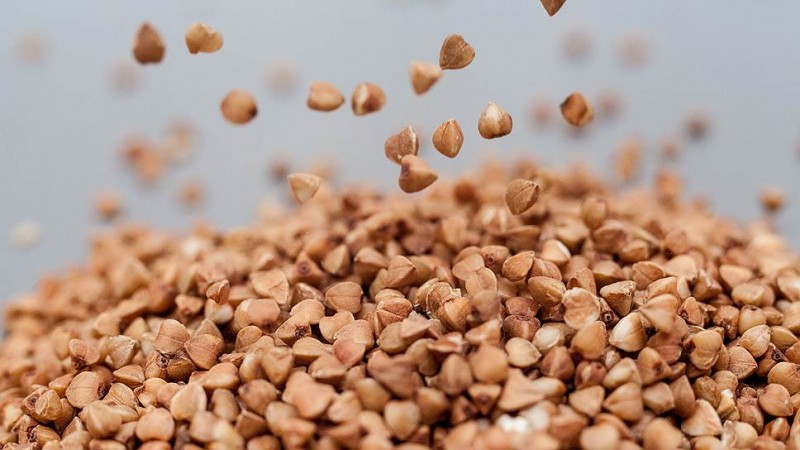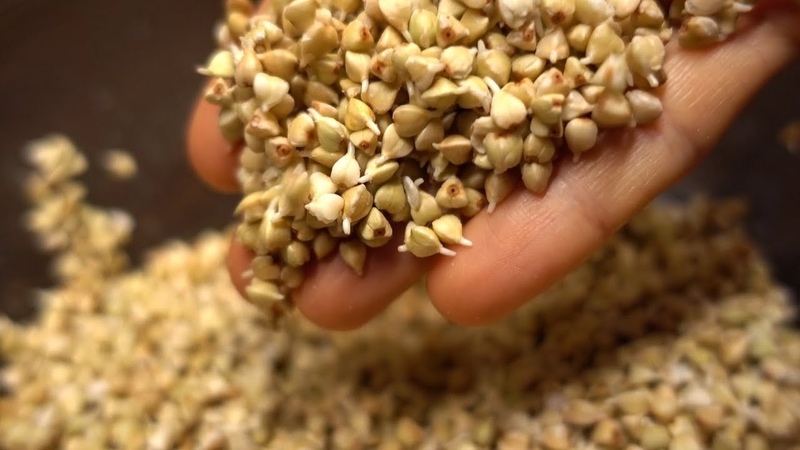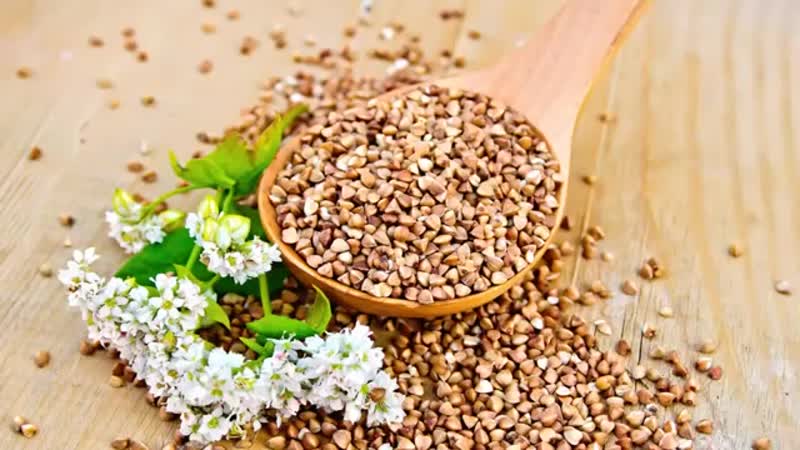The benefits and harms of buckwheat for human health
Buckwheat is a popular and irreplaceable grain in almost every kitchen. The usefulness of buckwheat is due to its rich composition. Due to its properties, buckwheat is used not only in cooking, but also in folk medicine. Also, this product is indispensable for those who want to say goodbye to extra pounds.
From the article you will find out what the benefits and possible harm of buckwheat are, how to correct it use and buy.
The content of the article
Buckwheat composition
100 g of the product contains:
- complex carbohydrates - 61 g;
- proteins - 12.6 g;
- fats - 3.3 g;
- dietary fiber - 11.3 g;
- saturated fatty acids - 0.6 g;
- unsaturated fatty acids - 2.28 g;
- mono- and disaccharides - 1.4 g;
- starch - 55.4 g;
- vitamins A, B1, B2, B6, B9, C, E, PP;
- minerals potassium, calcium, magnesium, sodium, phosphorus, sulfur, iron.
The total calorie content is 308 kcal.
Benefits for the human body
Due to its vitamin and mineral composition, buckwheat is considered useful for both men and women. Groats are used not only for culinary, but also for dietary and medicinal purposes.
For diseases and for their prevention

Buckwheat is used in various fields of medicine:
- Satisfies the feeling of hunger for a long time, but at the same time does not allow you to gain extra pounds. That is why nutritionists recommend including it in their diet for overweight people.
- Reduces the level of bad cholesterol in the blood when consumed regularly. This prevents the development of atherosclerosis and liver diseases.
- Stimulates the motor-evacuation function of the large intestine, which means it helps fight chronic constipation.
- It is used in the treatment of boils, carbuncles, abscesses and wet eczema.
- Increases hemoglobinthereby preventing anemia.
- Potassium in buckwheat maintains a normal level of blood pressure, regulates the contraction of the heart muscle.
- Thiamine prevents disorders of the gastrointestinal tract, cardiovascular and central nervous system.
- Vitamin PP normalizes the digestive tract, central nervous system, accelerates metabolism.
- Manganese regulates the synthesis of the hormone insulin.
Types of buckwheat and differences in benefits
Buckwheat can be found on store shelves in different forms:
- The core. This is a whole grain cereal. The larger it is, the correspondingly more expensive. It is mainly used for cooking cereals, side dishes and other dishes. It contains a lot of easily digestible protein and is useful for low hemoglobin levels. Recommended for kidney and liver diseases, a tendency to edema. Increases immunity. It is useful for gastritis and other diseases of the gastrointestinal tract.
- Done, cut... These are chipped kernels. It costs less than unground and cooks faster. Strengthens capillaries, cleanses the liver, is easily absorbed by the intestines, lowers cholesterol.
- Smolensk groats... She made it finer. Ideal for lovers of viscous porridge. Recommended for people with intestinal diseases.
- Flakes. They are obtained from whole grain, flattened and steamed. The flakes boil quickly. However, their nutritional value is lower than that of the kernel. Useful for people suffering from anemia. It is also a source of easily digestible protein. The flakes are suitable for baby and diet food.
- Flour. This is ground grain. It makes pancakes and pancakes, baby cereals.It normalizes the brain and nervous system, improves blood circulation, strengthens the immune system, and regulates metabolism. It has a positive effect on skin, hair and nails. Improves the digestion process.
- Green buckwheat... These are still unprocessed kernels. It is used in dietary nutrition and for germination. Due to the increased content of antioxidants, it maintains strength, health and youth, regulates the intestines, cleanses the body, improves metabolism, promotes weight loss.

Is buckwheat equally useful for everyone
Buckwheat in any form improves health and brings invaluable benefits. Its use has a positive effect on digestion, metabolism, vascular function, heart, etc.
If we talk only about the male body, then its inclusion in the diet:
- normalizes the psycho-emotional background;
- stimulates the production of the hormone of pleasure (dopamine);
- improves potency and increases libido.
Eating buckwheat has a positive effect on women's health:
- Promotes weight loss.
- Regulates the work of the endocrine glands and reproductive organs. Eliminates hormonal imbalance. In women who regularly use buckwheat, PMS and menopause pass easier.
- Prevents anemia, which is more beneficial and important for pregnant women.
- Prevents vitamin deficiency and postpartum depression.
- Regulates sudden surges in blood glucose.
- Improves the condition of hair, skin and nails.
Buckwheat is recommended to be introduced into complementary foods from 6 months. From infancy, it has a positive effect on the development of the child and the body as a whole:
- Strengthens the immune system. This is due to the routine in buckwheat, which enhances the effects of vitamin C.
- Promotes the proper development of the muscular system.
- Improves digestion.
- Prevents anemia.

Consumption rates per day
There are no established norms for the consumption of buckwheat per day. Doctors advise starting the morning with it, because complex carbohydrates provide the body with energy for about 2-3 hours. But they recommend giving up buckwheat for dinner. If the stomach is loaded in the evening, it will have to work for a long time at night, and this is harmful to health.
It is not recommended to eat buckwheat alone for a long time and in large quantities. It is important to supplement the diet with other plant and animal foods. Since complex carbohydrates are concentrated in buckwheat, a strong load is created on the gastrointestinal tract, which will fail over time.
Application
Buckwheat is not only nutritious and healthy porridge. Thanks to the beneficial substances it contains, cereals are also used as a medicine.
In cooking

Buckwheat is great for children and adults. Dishes made from buckwheat are served as a side dish or as an independent treat (from cereals for breakfast to desserts made from buckwheat flour):
- from the kernel we get the crumbly porridge familiar to us;
- done, the cut is quickly boiled down and is ideal for baby food;
- casseroles are often prepared from Smolensk groats, as well as fillings for pies;
- flakes are used for instant porridge and baking diet cereal bread;
- buckwheat flour is used to make noodles, bake bread, pancakes, buns, etc .;
- green buckwheat is eaten raw or sprouted, adding to salads.
In folk medicine

Buckwheat is also often used in folk medicine.
There are effective recipes based on it:
- Shredded buckwheat leaves or buckwheat flour are used to treat boils, purulent wounds, etc.
- With the help of juice from the leaves, they fight conjunctivitis.
- Buckwheat honey copes well with colds, problems of the gastrointestinal tract.
- Buckwheat flowers and leaves are also useful for the treatment of measles, scarlet fever, upper respiratory tract diseases, for strengthening the walls of blood vessels, and wound healing.
- To cope with heartburn, it is enough to chew a few kernels of buckwheat.
- The husks are stuffed with pillows, which are recommended for use for insomnia and osteochondrosis.
Slimming
Buckwheat is an effective weight loss aid. Its compounds contribute to weight loss and body detoxification:
- fiber removes toxins and toxins from the intestines, improves digestion, creates a feeling of satiety;
- organic acids do not allow carbohydrates and lipids to be stored as fat stores;
- complex carbohydrates are absorbed for a long time and prolong the saturation of the body;
- vitamins normalize metabolism;
- minerals remove toxins, excess fluid, optimize blood sugar levels.
Selection and storage rules

To buy high-quality buckwheat groats, evaluate it by the following characteristics:
- Blossom. If the buckwheat is dark, then most likely it is grown in China (this should also be written on the package). Buckwheat acquires this color after roasting, and during heat treatment, some of the nutrients disappear.
- Impurities (unprocessed grains and small stones). The fewer there are, the better the product is. The kernel variety will help determine this. The first grade is the best, but the third contains about 10% of impurities and requires mandatory sorting.
- Availability of GOST and varietal accessories, which must be indicated on the package.
- I smell. Spoiled buckwheat will give out a pronounced unpleasant smell of mold or mustiness.
- Date of production and packaging... The storage period should not exceed 20 months.
To preserve the taste of buckwheat for a long time, follow the storage rules:
- humidity - no more than 60%;
- temperature - from + 5 ° С to + 15 ° С;
- container - after purchase, pour the cereal into a glass or plastic container that closes tightly, or into a canvas bag;
- storage location - dry, warm and well protected from sunlight;
- lack of pronounced odors - any cereal absorbs them.
For longer storage, it is recommended to dry the buckwheat in the oven or in a pan.
Who is buckwheat contraindicated
Buckwheat is not recommended for use when:
- individual intolerance - provokes allergic reactions;
- increased blood clotting - vitamin P in cereals will aggravate the condition.
With excessive use of buckwheat, the following may appear:
- sensitivity to cold;
- tingling or numbness in the hands;
- inflammation of the skin in areas exposed to direct sunlight.
Reviews
Buckwheat is not only a popular and tasty porridge that many families include in their diet. It is a preventive and curative remedy for many diseases, as well as an effective dietary product. The usefulness of cereals is proved by consumer reviews.
Christina, 49 years old: «Our whole family adores buckwheat. And in any form. I cook it at least 2-3 times a week. The only negative is that when you eat it, it is difficult to stop, because it is very tasty! "
Irina, 21 years old: “When I donated blood for the last time, they said that I had low hemoglobin. They advised to eat more buckwheat. So I not only raised it, but now the hair falls out less, and the nails look better. "
Conclusion
Buckwheat is good for health at any age. Even half-year-old babies are allowed to use it. This cereal is easy to choose and store at home. It is used in cooking, folk medicine, and dietary nutrition. Buckwheat has practically no contraindications, but it is better to discuss the norms of its consumption with a doctor in advance.